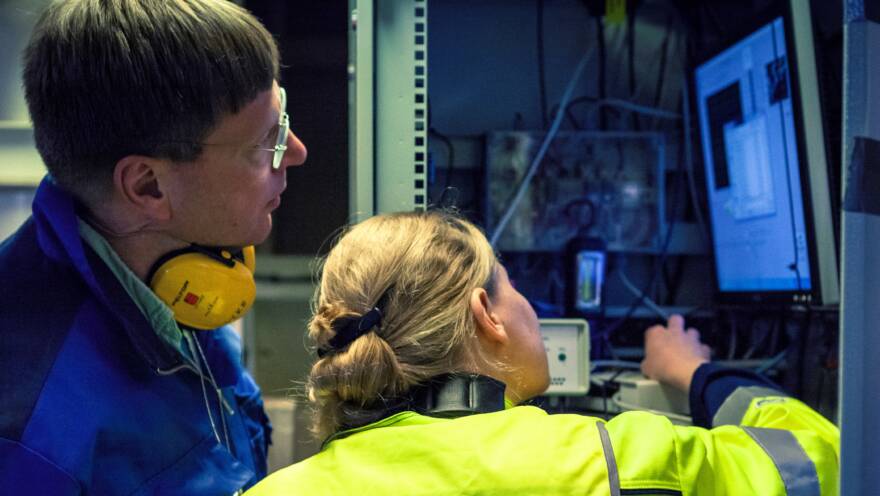
Variations in salinity and temperature cause stratification
The Baltic Sea differs from the oceans in both salinity and temperature. The regional differences within the Baltic Sea are significant. Vertically, salinity and temperature vary even more. This resulting water stratification has a major impact on life in the Baltic Sea.
The salinity of the Baltic Sea water is on average about 7 parts per thousand. This number applies well to the surface waters of the main basin of the Baltic Sea. However, salinity is not the same everywhere. In the Danish straits, it is significantly higher, around 20 parts per thousand, and correspondingly lower in the innermost parts of the Gulf of Finland and the Bothnian Bay, at 0–3 parts per thousand. Such a change in salinity is characteristic of the funnel-shaped estuaries of rivers flowing into the oceans. In a sense, the Baltic Sea can be considered a giant estuary when viewed on an oceanic scale.
In terms of temperature, the Baltic Sea is also an oddity among seas. The surface water temperature of the Baltic Sea varies so much throughout the year that, in this respect, the water body resembles a large lake more than a sea.
Temperature varies by region and depth
In winter, the sea water temperature often drops below freezing because brackish water has a lower freezing point than freshwater. In summer, the surface water temperature is highest in the southern Baltic Sea, the eastern Gulf of Finland, and the Gulf of Riga. The water is usually warmest near the coast and in shallow areas. At its peak, the water temperature in summer averages 15–18 degrees Celsius, slightly lower in the north. Near the coast and in shallow areas, the surface water temperature can rise to almost 30°C on a hot, windless summer day. However, upwelling of deep water to the surface can cause large and rapid temperature fluctuations along the coast.
Upwelling
If the wind blows for a long time along a coastline such that the shore is on the left relative to the wind’s direction, a phenomenon known as upwelling may occur. In such cases, the wind transports warm surface water to the open sea and cold water wells up from the deep to the surface to replace it. The upwelling water is cold and nutrient-rich and eutrophicates the surface layer, i.e. stimulates the growth of aquatic plant life usually resulting in the depletion of dissolved oxygen. In addition, in the Gulf of Finland, a strong offshore wind, i.e. blowing directly from land to sea, can also cause upwelling near the shore.
Although the surface water is warm in summer, the deeper water remains consistently cold throughout the year. Water is heaviest at +4 degrees Celsius, and water layers of different temperatures do not mix. The narrow layer of water between the warm and cold water is called the thermocline. In this layer, the temperature can drop by ten degrees over a few metres.
The entire Baltic Sea stratifies by temperature in summer. However, the thermocline is not a permanent phenomenon; it only forms in summer. In autumn, when the surface water also cools to four degrees Celsius, the water masses mix, and the temperature stratification breaks down.
Salinity has a strong impact on water stratification
There is also a clear depth gradient in water salinity: the water in the deep basins is much saltier than the surface water. This is because saline water is heavier than the less saline surface water. The stratification caused by salinity is permanent; water layers with different salinities do not mix. The largest area of saline water mass is found in the Gotland Deep.
Between the less saline surface water and the dense deep water, a halocline forms, where salinity increases sharply over a short distance. The halocline is typically located deeper than the thermocline.
Salinity stratification is a permanent phenomenon in the Baltic Sea, and the seasons do not significantly affect it. Therefore, the deep water below the halocline does not get much exchange, and especially the central parts of the Baltic Sea and the Gulf of Finland often suffer from oxygen depletion.
The Bothnian Bay is a unique case with only weakly stratified water
The Bothnian Bay is separated from the rest of the Baltic Sea by the shallow threshold of the Åland Sea. In this area, the sea is only 60–70 metres deep. The threshold prevents the saline and dense deep water from the main basin of the Baltic Sea from entering the Bothnian Bay. Therefore, the Bothnian Bay does not have the same strong salinity stratification as the central parts of the Baltic Sea and, for example, the Gulf of Finland.
The water in the Bothnian Bay does stratify according to temperature. However, due to the lack of salinity stratification, the water in the Bothnian Bay can mix all the way to the bottom in autumn when the surface water cools. As a result, the oxygen situation at the bottom of the Bothnian Bay is better than in other parts of the Baltic Sea.
-
 Find out more
Find out moreCurrent observations
-
 Find out more
Find out moreResearch: Water quality

